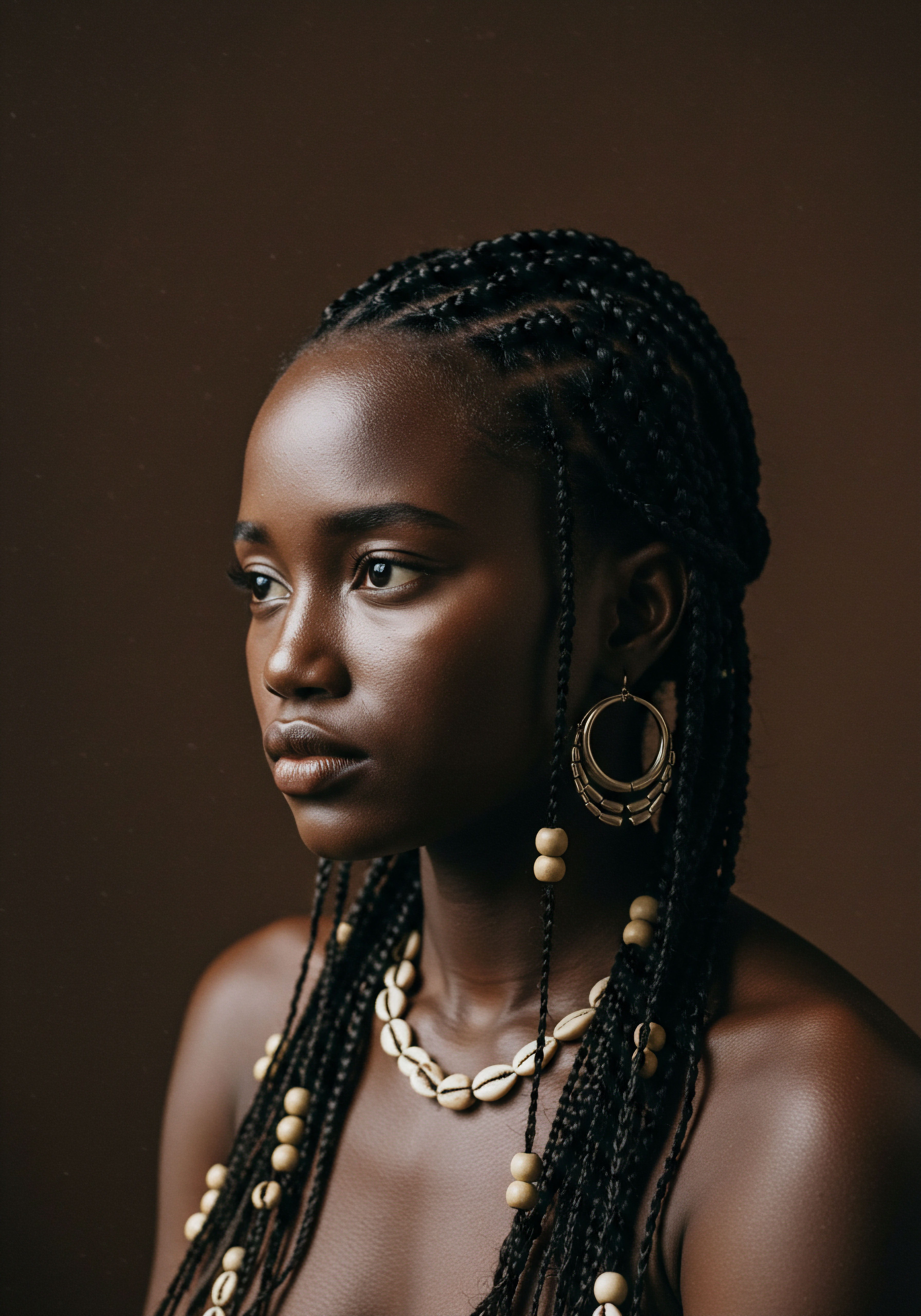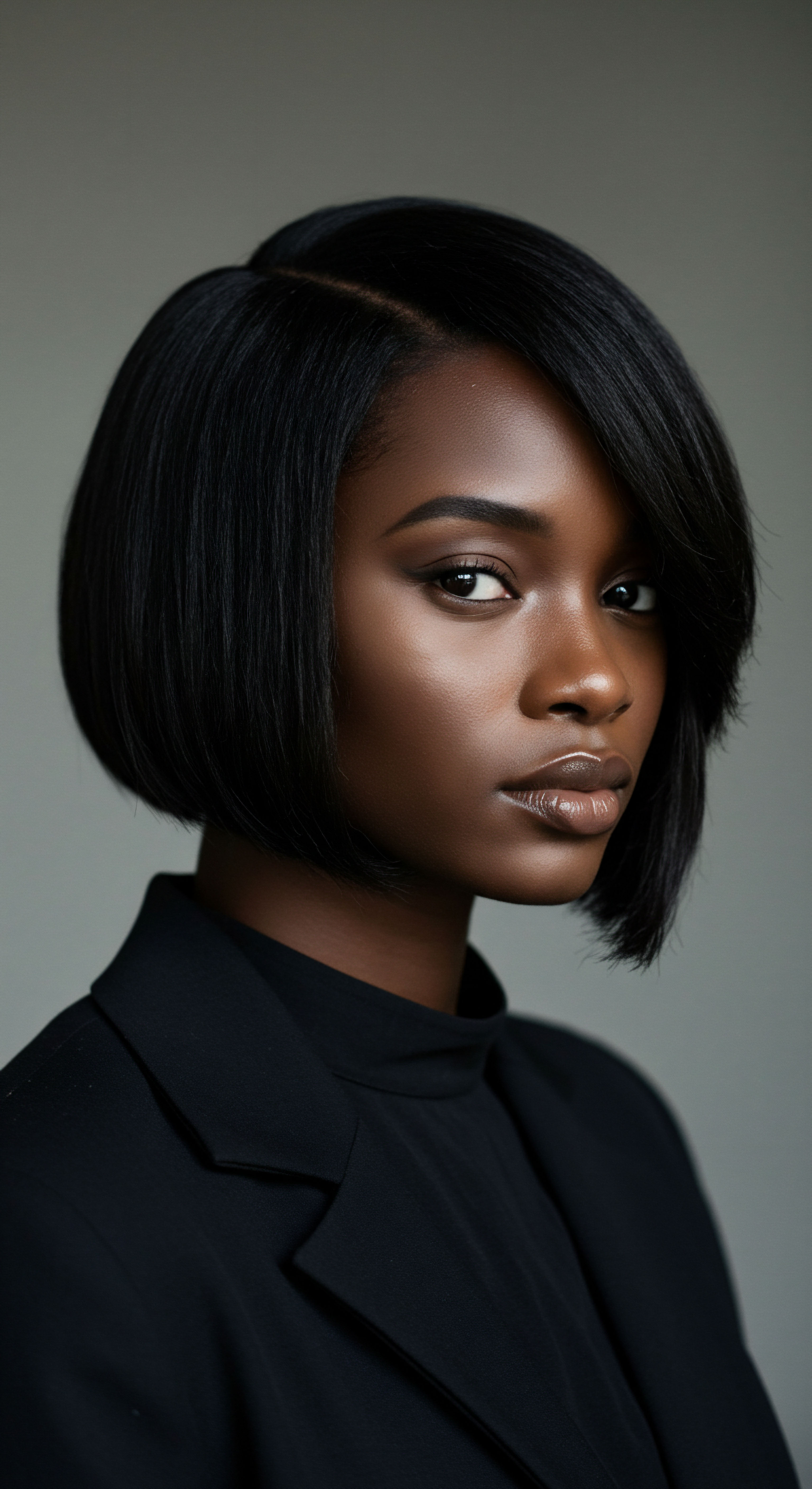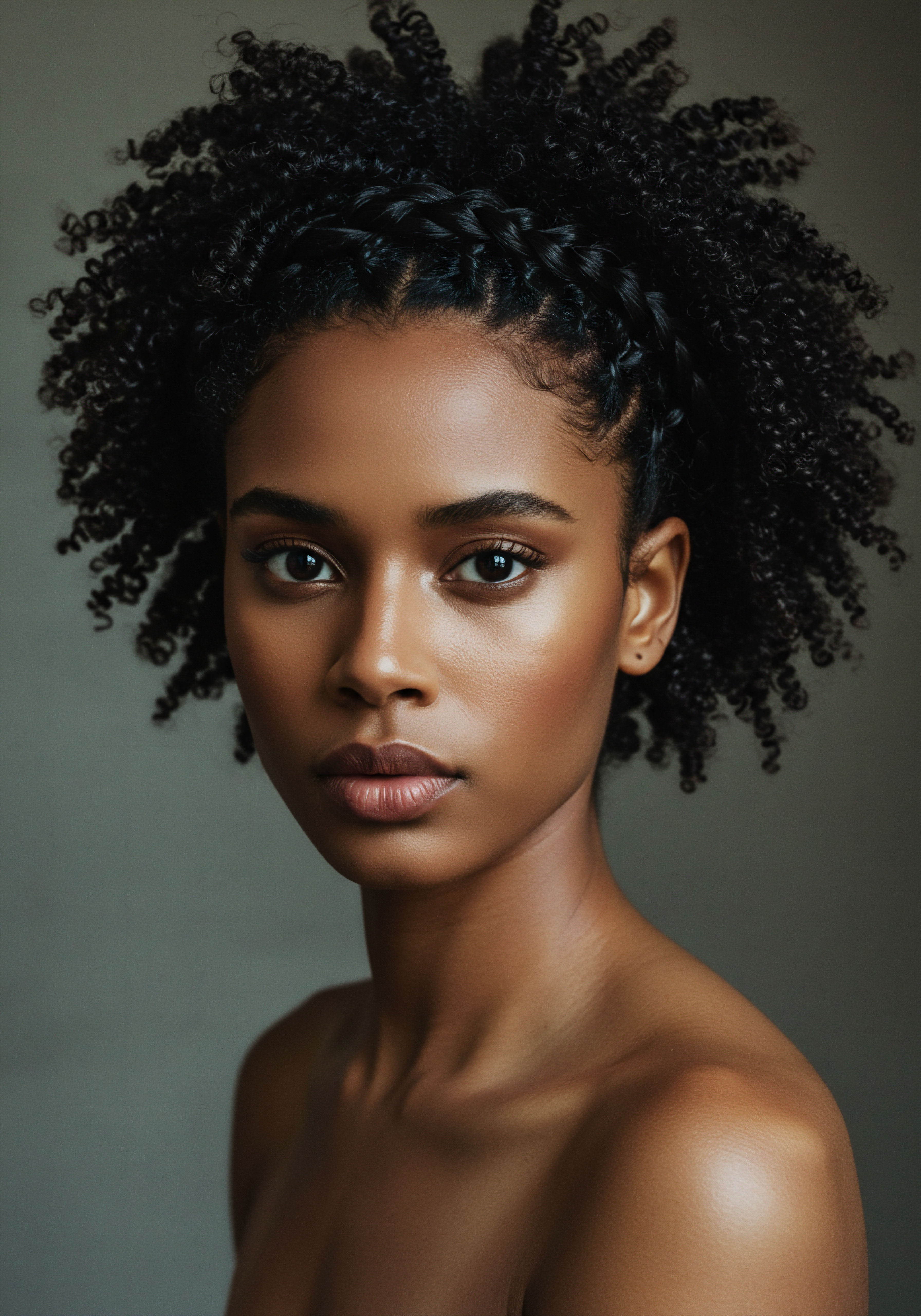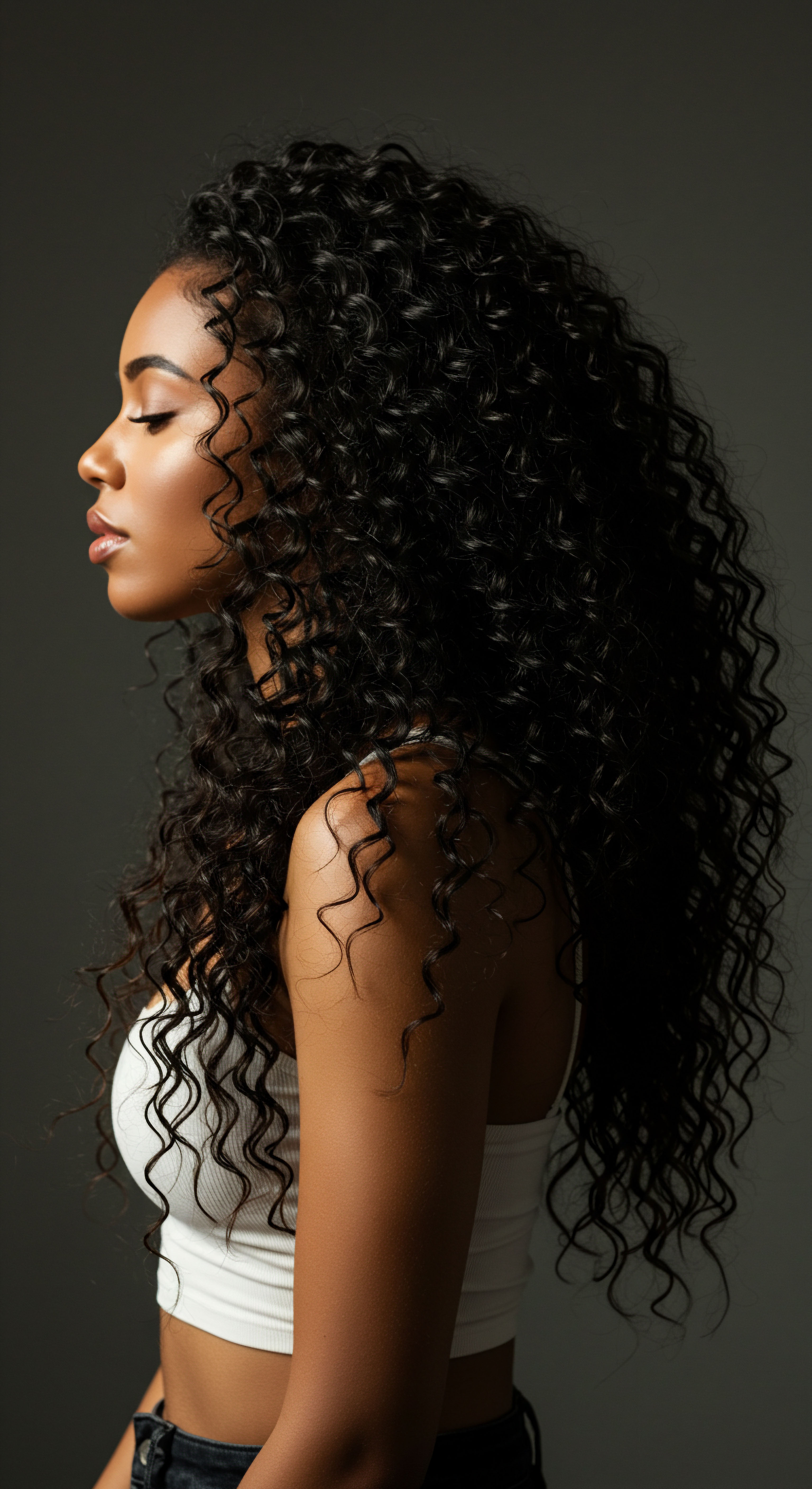
Roots
The quiet hours of the night, often perceived as a mere pause in our daily rhythms, hold a profound significance for the delicate balance of our being. Within this unseen realm of rest, a subtle alchemy unfolds, impacting everything from the clarity of our thoughts to the vitality of our hair. For those with textured hair, a lineage of strands that carry stories of resilience and beauty, the question of how disturbed sleep patterns might affect their unique structure carries a particular weight. It is an inquiry that reaches beyond superficial concerns, delving into the very foundations of cellular renewal and physiological harmony that underpin the health of each coil and curl.

The Hair’s Own Rhythmic Dance
Our hair, far from being inert, participates in an intricate biological choreography, a cyclical process of growth, transition, and rest. This rhythm, often called the hair growth cycle, is deeply intertwined with the body’s broader circadian clock, that internal timekeeper guiding our sleep-wake patterns, hormone release, and cellular repair. When this internal clock falls out of sync, the consequences ripple through our entire system, potentially reaching the very cells responsible for creating and maintaining our textured strands.
Consider the hair follicle, a miniature organ residing beneath the scalp’s surface. This follicle operates on its own precise schedule, moving through distinct phases:
- Anagen ❉ The active growth phase, where hair cells divide rapidly, forming new hair. This period can last for years.
- Catagen ❉ A brief transitional phase, where growth ceases, and the follicle begins to shrink.
- Telogen ❉ The resting phase, during which the hair remains in the follicle, essentially dormant, before eventually shedding to make way for new growth.
Disruptions to our sleep, whether through inconsistent schedules or insufficient hours, can throw this delicate follicular timing into disarray. The body, perceiving a state of disequilibrium, may prematurely push hair follicles from the active anagen phase into the resting telogen phase. This acceleration of the resting phase can result in increased shedding and a noticeable reduction in overall hair density over time.

Why is Cellular Repair at Night Important?
The quietude of night is when our bodies are most dedicated to repair and regeneration. During deep sleep stages, a surge of essential growth hormones, including those that directly influence hair follicle activity and cell regeneration, are released. These hormonal shifts are critical for the protein synthesis that builds the very structure of our hair.
When sleep is consistently compromised, the body’s capacity for these vital reparative processes diminishes. Hair follicles, deprived of this nightly restorative period, may become less efficient in their function, leading to weaker, more vulnerable strands.
The silent hours of slumber are not merely a pause from activity, but a dynamic period of cellular renewal and hormonal rebalancing, profoundly influencing the very foundation of our hair’s vitality.
Beyond hormones, blood flow to the scalp also sees an uptick during deep sleep. This increased circulation ensures a steady supply of oxygen and nutrients to the hair follicles, providing the sustenance they need for optimal growth. Conversely, restricted blood flow due to poor sleep can hinder this crucial delivery system, potentially resulting in slower-growing hair and compromised strand health.
| Hair Cycle Phase Anagen (Growth) |
| Description Active cell division, hair lengthening. |
| Impact of Disturbed Sleep Shortened, leading to less growth. |
| Hair Cycle Phase Catagen (Transition) |
| Description Follicle shrinks, growth stops. |
| Impact of Disturbed Sleep Potentially accelerated transition. |
| Hair Cycle Phase Telogen (Resting) |
| Description Hair is dormant, prepares to shed. |
| Impact of Disturbed Sleep Premature entry, increased shedding. |
| Hair Cycle Phase Exogen (Shedding) |
| Description Old hair falls out. |
| Impact of Disturbed Sleep Increased incidence due to telogen acceleration. |
| Hair Cycle Phase Understanding these phases helps illuminate how consistent sleep patterns support healthy hair progression. |

Ritual
Stepping from the foundational understanding of our hair’s inner workings, we arrive at the realm of daily and nightly practices. Here, the wisdom of self-care intertwines with the tangible effects of our sleep patterns, shaping the tangible feel and appearance of textured hair. Many of us instinctively reach for products and techniques to address concerns like dryness, breakage, or a lack of vibrancy.
Yet, the subtle, often overlooked, influence of how we rest can either support or undermine these diligent efforts. The question then becomes ❉ how do our nighttime habits, or the lack thereof, contribute to specific textured hair concerns, and what gentle adjustments might invite a more serene outcome?

The Delicate Balance of Moisture and Sleep
Textured hair, by its very structure, tends to be more prone to dryness due to the way its coils and curls lift the cuticle layer, allowing moisture to escape more readily. During our waking hours, we might diligently apply leave-ins, creams, and oils to seal in hydration. However, the nighttime can present a silent challenge.
When sleep is consistently disrupted, the body’s internal regulatory systems, including those that influence sebum production and the scalp’s natural moisture barrier, can falter. This can lead to a scalp environment that is either excessively oily or, more commonly for textured hair, increasingly dry and prone to irritation.
A dry scalp, in turn, often manifests as itching, a sensation that can disturb sleep further and, when scratched, lead to micro-abrasions that compromise the scalp’s protective layer. This cycle of dryness, irritation, and disrupted rest can ultimately impact the integrity of the hair shaft itself, leaving it more vulnerable to breakage and a diminished appearance.

Protective Styling as a Nocturnal Shield
For generations, individuals with textured hair have recognized the importance of protective measures during sleep. The simple act of wrapping hair in a silk scarf or bonnet, or sleeping on a silk pillowcase, is far from a mere aesthetic choice. These practices serve as a crucial shield against the friction and moisture loss that can occur when hair rubs against absorbent cotton pillowcases.
Consider the mechanics ❉ cotton, with its thirsty fibers, readily draws moisture from hair, leaving it parched and susceptible to tangling and breakage. The inherent fragility of textured strands, particularly at the ends and along the curl pattern, makes them especially vulnerable to this nightly abrasion. A silk or satin surface, conversely, allows hair to glide smoothly, preserving moisture and minimizing mechanical stress. This physical protection is a cornerstone of maintaining curl definition and reducing frizz, concerns often amplified by a lack of thoughtful nighttime care.
The nightly ritual of protecting textured hair transcends mere preservation; it becomes a deliberate act of care that safeguards moisture, prevents mechanical stress, and honors the inherent fragility of each strand.

Does Sleep Deprivation Worsen Breakage?
The connection between sleep patterns and hair strength extends beyond physical friction. When sleep is chronically disturbed, the body enters a state of heightened stress, leading to an increase in cortisol levels. This stress hormone has been linked to a reduction in the synthesis of important skin elements like hyaluronan and proteoglycans, which are essential for hair follicle function and overall hair strength. A compromised hair follicle environment, coupled with increased stress, can result in hair that is simply weaker and more prone to snapping.
Furthermore, a lack of quality sleep can hinder the body’s ability to properly absorb nutrients. Even with a well-balanced diet, if the body is not adequately resting, the efficiency of nutrient uptake and delivery to the hair follicles can be compromised. This internal nutritional deficit, alongside external stressors, contributes to hair that lacks its usual resilience and sheen, making it more susceptible to concerns like split ends and overall dullness.
- Silk Pillowcases ❉ These surfaces reduce friction, which can help preserve the integrity of the curl pattern and minimize breakage.
- Hair Bonnets ❉ A soft, breathable bonnet protects hair from tangling and keeps moisture locked in, especially beneficial for retaining definition.
- Loose Protective Styles ❉ Braids or twists worn loosely at night can prevent knots and reduce stress on the scalp and individual strands.

Relay
Moving beyond the visible effects and daily practices, we now step into a deeper consideration of how disturbed sleep patterns can subtly alter the very architecture and resilience of textured hair. This exploration requires us to consider the intricate dance between internal biological rhythms, stress responses, and the unique characteristics of coily, kinky, and curly strands. How might the quiet chaos of restless nights translate into tangible changes in hair texture, strength, and even its capacity for sustained health? This inquiry compels us to look at the intersection of cellular signaling, hormonal cascades, and the lived experience of those navigating the nuances of their hair.

How Does Circadian Rhythm Disruption Affect Hair Follicle Stem Cells?
The hair follicle, that remarkable factory of hair, houses a population of stem cells crucial for regenerating new hair during each growth cycle. These stem cells are highly sensitive to changes in their micro-environment, including hormonal fluctuations and oxidative stress. Intriguingly, these stem cells also exhibit a biological clock, with their activity influenced by the body’s circadian rhythm.
A compelling study published in Cell Reports in 2019 illuminated this connection, finding that chronic circadian rhythm disruptions, such as those experienced by shift workers, led to a decrease in stem cell activity within hair follicles. This diminished regenerative capacity, over time, can result in hair that is noticeably thinner and weaker. The very “engines of regrowth” are slowed, compromising the hair’s ability to fully recover and maintain its robust structure. This speaks to a fundamental impact on the hair’s future, not just its present state.
Furthermore, the core clock genes, like BMAL1 and PER1, play a significant role in regulating the hair growth cycle. Disruptions to these genes, which can occur with inconsistent sleep, may lead to subtle variations in the hair cycle. While some studies suggest that silencing these genes might even prolong the anagen phase in certain contexts, the broader implication of dysregulation points towards a compromised and less predictable growth pattern.

Can Chronic Stress Alter Hair Pigmentation and Texture?
One of the most potent internal forces affected by disturbed sleep is the body’s stress response. Chronic lack of sleep elevates levels of cortisol, the primary stress hormone. While cortisol is essential for our daily functioning, sustained high levels can be detrimental. In the context of hair, elevated cortisol has been shown to reduce the synthesis and accelerate the degradation of important skin components, namely hyaluronan and proteoglycans, by approximately 40%.
These substances are vital for the proper function and cyclic regulation of the hair follicle. Their degradation can directly impact the hair’s ability to maintain its structural integrity, potentially leading to changes in its elasticity and overall feel.
Beyond structural changes, the interplay between stress and hair extends to pigmentation. Oxidative stress, which can be heightened by chronic sleep deprivation, has been linked to a gradual deterioration of cellular structures, including melanocytes—the cells responsible for producing hair color. This imbalance can lead to a reduction in the activity of tyrosinase, a key enzyme in the melanogenesis process, ultimately manifesting as premature graying. For textured hair, where color plays a significant role in its visual richness and cultural identity, this subtle shift can be a particularly poignant concern.
Chronic sleep disturbances can subtly alter the hair’s very essence, impacting not only its strength and growth potential but also its inherent elasticity and color vibrancy.
The concept of hair cortisol concentration (HCC) as a biomarker for long-term stress exposure provides a fascinating lens through which to consider these effects. Hair grows approximately 1 centimeter per month, allowing for the assessment of average cortisol levels over a specific period. While direct studies linking HCC to specific textured hair concerns are still developing, the established connection between high cortisol and degradation of hair follicle modulators suggests a plausible mechanism for textural changes.

The Immune System’s Role in Hair Health and Sleep Disturbances
A robust immune system is a silent guardian of hair health. Sleep deprivation, however, can weaken this system, leading to an inflammatory response within the body. This inflammatory state can contribute to various hair loss conditions, including telogen effluvium and even exacerbate autoimmune conditions like alopecia areata. While telogen effluvium often presents as increased shedding, the underlying inflammation can also affect the hair follicle’s ability to produce healthy, strong strands, potentially altering the texture of new growth.
For textured hair, which can already be prone to scalp sensitivities and conditions like seborrheic dermatitis, an impaired immune response due to poor sleep could heighten these vulnerabilities. A 2019 experiment by Elma D. Baron and colleagues, comparing dermatological conditions between night and day workers, found that night workers were more exposed to skin conditions like seborrheic dermatitis, accompanied by itching.
This is attributed to an increase in pro-inflammatory cytokines, which can affect the scalp’s health and, by extension, the quality of hair growing from it. A compromised scalp environment can certainly influence how hair emerges, potentially leading to strands that are less defined, more brittle, or generally less resilient.
| Mechanism Hormonal Imbalance (Cortisol, Melatonin, Growth Hormone) |
| Specific Impact on Hair Disruption of hair growth cycle, reduced protein synthesis. |
| Potential Textured Hair Concern Increased shedding, slower growth, weakened strands. |
| Mechanism Stem Cell Activity |
| Specific Impact on Hair Decreased regenerative capacity of hair follicles. |
| Potential Textured Hair Concern Thinner, weaker new hair over time. |
| Mechanism Oxidative Stress |
| Specific Impact on Hair Damage to melanocytes, cellular structures. |
| Potential Textured Hair Concern Premature graying, altered elasticity. |
| Mechanism Inflammation |
| Specific Impact on Hair Compromised scalp health, potential for telogen effluvium. |
| Potential Textured Hair Concern Scalp irritation, less defined curls, brittleness. |
| Mechanism Nutrient Delivery |
| Specific Impact on Hair Reduced blood flow to scalp, inefficient nutrient uptake. |
| Potential Textured Hair Concern Dullness, lack of vitality, increased breakage. |
| Mechanism These interconnected biological processes highlight the systemic nature of sleep's influence on hair health. |

Reflection
The quiet moments of slumber, often taken for granted, emerge as a profound canvas upon which the health and vitality of our textured hair are intricately painted. From the unseen rhythms governing cellular life within each follicle to the delicate balance of hormones and the very integrity of our strands, the echoes of disturbed sleep patterns reverberate with tangible consequences. It is a gentle reminder that true hair wellness extends beyond topical applications and styling techniques, reaching into the deeper, quieter currents of our physiological being. To truly nurture textured hair, perhaps we must first attend to the serene embrace of restorative rest, allowing the body’s innate wisdom to renew and revitalize, strand by precious strand.

References
- Clinikally. (2024, July 16). Impact of Sleep Deprivation on Hair Health.
- DiStefano Hair Restoration Center. (2025, March 7). Does Sleep Affect Hair Health?
- HairFree & HairGrow. (2023, October 27). Sleep and Hair Loss. Relationship Explained.
- Treatment Rooms London. (2024, March 2). Can A Lack of Sleep Cause Hair Loss?
- The Curly Store. (2020, September 19). HOW SLEEP AFFECTS YOUR HAIR.
- HHC Clinics. Sleep and Hair Growth – What’s the Connection?
- DermiMatch Hair Clinic. (2024, February 11). Lack of Sleep and Hair Loss ❉ Exploring the Evidence.
- Limmer Hair Transplant Center. (2025, January 2). Can Lack of Sleep Cause Hair Loss?
- Parker, Harriet W. (2025). THE SLEEP-HAIR CONNECTION ❉ Harness The Power of Nighttime Hormones for Hair Growth and Vitality.
- Kwan, Tessa. (2025, March 13). Sleep Beauty. Publifye.
- PHS HAIRSCIENCE. (2024, May 3). How Lack of Sleep is Causing Hair Loss & Affecting Your Hair Growth.
- Hair Doctors. (2025, April 2). Can Lack of Sleep Make You Lose Hair? Uncovering the Connection.
- Zhang, Y. et al. (2023, January 26). Hair Follicles as a Critical Model for Monitoring the Circadian Clock. PMC – PubMed Central.
- Hims. (2024, November 24). Does Lack of Sleep Cause Hair Loss? Uncovering the Connection.
- Mayo Clinic. (2024, October 2). Does Lack of Sleep Cause Hair Loss? The Science Explained.
- La Bonne Brosse. (2025, April 25). Lack of Sleep ❉ What Impact on Hair Health?
- Vegamour. (2021, April 16). Does Lack of Sleep Cause Hair Loss?
- Centre Clauderer. Hair and sleep ❉ the importance of the night for hair health.
- The Importance of Good Sleep for Healthy Hair and Skin. (2022, February 25).
- L’Oréal Paris. (2022, August 17). How Sleep Is Affecting Your Hair.
- Geyfman, M. & Andersen, B. (2010). Clock genes, hair growth and aging. Aging-US.
- HHC Clinics. (2025, March 11). Sleep and Hair Growth ❉ How Your Nighttime Hair Care Routine Impacts Your Hair.
- LearnSkin. (2017, November 5). How Does the Circadian Rhythm Affect Hair Growth?
- Geyfman, M. & Andersen, B. (2014). Clock genes, hair growth and aging. Aging-US.
- Capilclinic Blog. How does Insomnia affect hair?
- Gathers, D. M. & Khumalo, N. P. (2021, February 19). Techniques Used for Hair Style Maintenance while Sleeping May Be a Risk Factor for Traction Alopecia. PMC.
- The Science of Beauty Sleep ❉ How Rest Affects Your Appearance.
- Harley Street Hair Clinic. Emotional stress and hair loss.
- Typology. (2024, March 6). The consequences of a lack of sleep on your hair.
- Loussouarn, G. et al. (2001). African hair growth parameters. ResearchGate.
- Lin, J. et al. (2023, July 3). Overview of the Circadian Clock in the Hair Follicle Cycle. PMC – PubMed Central.
- Xiang, Y. et al. (2017). Hair Cortisol Concentrations Are Associated with Hair Growth Rate. ResearchGate.
- Zhang, Y. et al. (2023, January 26). Hair Follicles as a Critical Model for Monitoring the Circadian Clock. MDPI.
- Gavazzoni, R. & Truzzi, F. (2016). Stress and the Hair Growth Cycle ❉ Cortisol-Induced Hair Growth Disruption. Journal of Drugs in Dermatology.
- Ren, S. et al. (2025, March 21). Melatonin’s Role in Hair Follicle Growth and Development ❉ A Cashmere Goat Perspective.
- Gavazzoni, R. & Truzzi, F. (2016). Stress and the Hair Growth Cycle ❉ Cortisol-Induced. Journal of Drugs in Dermatology.
- Cedirian, S. & Prudkin, L. (2023). The exposome impact on hair health ❉ etiology, pathogenesis and clinical features – Part I. Anais Brasileiros de Dermatologia.
- Sauvé, M. et al. (2015). Chemical processing and shampooing impact cortisol measured in human hair. PMC.
- Jablonski, N. G. & Chaplin, G. (2020). Human scalp hair as a thermoregulatory adaptation. PNAS.